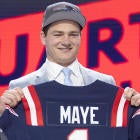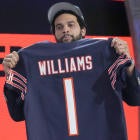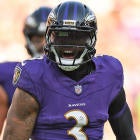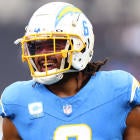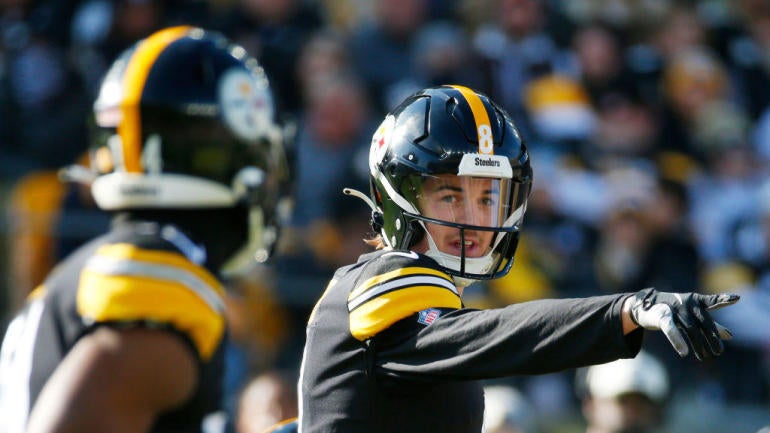
The 2022 NFL Draft class of quarterbacks was unusual -- devoid of a must-have top 10 talent, and the second quarterback wasn't selected until the third round. Rare. Yet there are four passers from that 2022 draft class set to start this season.
Let's look back on these quarterbacks as prospects, pinpoint what they must improve, how their strengths can be maximized and formulate a projection for their second seasons factoring in their supporting casts.
To check out my outlook for the rookie class of quarterbacks, click here.
How he's improved
This section isn't exactly fair to these second-year pros because, of course, the leap from college to the NFL almost always comes with growing pains and humbling first-year experiences.
And, heck, Pickett even experiencing the tiniest possible dip in Turnover-Worthy Play Rate from his final season at Pittsburgh to last season in the NFL is a major win (2.6% to 2.5%). In essence, he took care of the football awesomely for a rookie. A few of the other key quarterback advanced metrics were lower, but not drastically, except for Adjusted Completion Rate (75.3% in his Pittsburgh career to 71.3% in 2022 in the NFL).
Supporting cast
The Steelers organization knows how to build a roster around a quarterback. Sure, Omar Khan is relatively new on the job at GM, but he learned from brilliant team-building GM Kevin Colbert starting in 2001. In any direction Pickett looks, he has a young, fun weapon. On the perimeter, there is George Pickens, who's seemingly gotten so bored with normal look-the-ball-in catches he's actively attempting to intensify the difficulty of back-shoulders and jump balls to top his previous viral grab.
Diontae Johnson is one of the slipperiest underneath separators in the NFL, and Pat Freiermuth has covertly stepped into the "next tier" at tight end behind Travis Kelce, George Kittle and Mark Andrews. He's gone over 60 grabs in each of his first two seasons and finished sixth among tight ends with 732 yards a season ago.
I was enamored with the uniqueness of Darnell Washington during the pre-draft process -- nearly 6-foot-7 and a strapping 260 pounds with offensive tackle-like blocking power. And even though he's about as big as an 18-wheeler, he accelerates much faster than one. There's sneaky fluidity to his game, too. And Washington's hands are like catcher's mitts. There are some tremendous 12 personnel possibilities in the short and long term in Pittsburgh.
The offensive line is a work in progress. But the work has been done to improve an average unit from Pickett's first season as the starter. The Steelers added arguably the top guard in free agency, Isaac Seumalo, from across the state in Philadelphia, and the club spent a first-round pick on physical specimen Broderick Jones, the left tackle from Georgia. I think he has some technical, pass-protection issues to work through, but he plays with plenty of pop on contact and glides to the second level.
Altogether, Pickett is now in an environment in which the Steelers won't wonder at the end of the season if they could've done more to help the young passer. That's all a team and a youthful quarterback can ask for.
Improving his weaknesses
Let's see more collegiate aggressiveness from Pickett in his second pro season. Take more command of the offense. Fewer checkdowns. More lasers to the intermediate level and bucket throws deep. Unsurprisingly, Pickett was a little timid at the outset of his rookie year with the Steelers, and we really didn't notice the light turning on for him until down the stretch. Even then, four of his final five games featured fewer than 200 passing yards, which is very pedestrian in today's NFL.
Sure, he could get more accurate with the football, too. I'm not overly concerned about that. Almost every passer sees an uptick in ball placement as they progress early in their careers, and I wouldn't even label Pickett's 63% completion rate from 2022 as alarmingly bad.
Strengthening his strengths
In his 2022 audition, Pickett wasn't noticeably strong in any particular area as a passer despite being reasonably careful with the football. Now, at Pittsburgh in 2021, his average depth of target was 9.6 yards -- compared to 8.0 with the Steelers last year. Every game he rifled the football all over the field with assertiveness and bought time with his legs when necessary.
Outside the pocket during his final season with the Panthers, Pickett threw 14 touchdown to just one interception. Last year with the Steelers, he finished with one touchdown and two interceptions outside the friendly confines of the pocket. I'd like to see more off-structure work from Pickett in his second Steelers season.
Season outlook
Pickett is in the best environment for a serious Year 2 breakout among his 2022 draft classmates. The receiver room is diverse in its talent. The offensive line is sturdy albeit unspectacular. I like Pickett to be widely considered a top-16 quarterback in the league after a strong 2023 campaign in Pittsburgh. The Steelers do quarterback development right.
How he's improved
Instead of bashing Ridder for an entire paragraph, I'll be short and sweet here. He had a rather customary rookie season for a non-first-round pick. Across the board, he was less effective than he was during his collegiate career.
Supporting cast
I low-key like what Ridder has around him in Atlanta, especially when the coach and his scheme are considered. Now, does Arthur Smith have a long history of producing high-volume, super-dynamic passing offenses? Of course not. His attack was integral in the revitalization of Ryan Tannehill's career and can generate supreme aerial efficiency.
Now for the personnel -- how many other third-round quarterbacks are the incumbent starter in Year 2 with three first-round skill position players and three former first-round offensive lineman on his offense? Not many.
Ridder has those luxuries, and everyone and their brother will be focusing attention on stopping Atlanta's well-oiled run game that finished fourth in EPA per play in 2022 before mega-hyped Bijan Robinson was added to it. In short, Ridder is essentially guaranteed to throw against heavy boxes, which means plenty of space at the intermediate level and down the field.
Then at receiver, 2022 first-rounder Drake London averaged 2.07 yards per route run as a rookie, a sizable figure for a first-year pro. And it's a stat that's decently predictive for future success. Kyle Pitts is too long and too ridiculous of an athlete to be restrained as much as he was before his season-ending injury last season.
The defense should be noticeably better, which will place Ridder in better game scripts, so he won't feel as pressured to force throws that aren't really there. That's huge.
Improving his weaknesses
This is straight from a scouting angle with Ridder -- he needs to be less sackable. What does that mean? Well, for example, in his final season at Cincinnati, 26.7% of his pressures turned to sacks, per TruMedia. That's red-flag high, particularly for a collegiate quarterback.
Last season in Atlanta, it was 20.9%. Not brutal but far from expected for someone of Ridder's athletic prowess. What a high pressure-to-sack rate indicates is a quarterback has problems eluding pressure. And while passing from a clean pocket remains the most stable year-over-year metric, we all know how vital improvisation ability has become for quarterbacks in the modern-day NFL.
Strengthening his strengths
Ridder is a freaky athlete. His collegiate play style, which was more stoic and traditional than anything else, didn't drive any narratives about how spectacular of a mover he is. At 6-foot-3 and 211 pounds, he tested in the 87th percentile and up at the quarterback position in the 10-yard split, 40-yard dash, vertical and broad jump at the 2022 combine.
Maybe Ridder is just more timid on the field than most who possess his natural athletic gifts, but I wouldn't mind seeing the Falcons gain a numbers edge on the ground with a few designed Ridder runs per contest. And he has big-time throw capabilities. His 6.5% BTT rate in his senior season at Cincinnati was darn good. It was only 2.5% in his rookie season with the Falcons. Let's see more deep-ball looks for Ridder this year, too.
Season outlook
Ridder will take a jump in Year 2. How big? That, I don't know. He entered the league with loads of experience after four years starting for the Bearcats and got 136 drop backs under his belt as a rookie. His head coach knows the run game and how to insulate a quarterback, and the talent around him alone will help boost his productivity.
Ridder is aligned to fit snugly into a clearly defined game-manager role, which is fine. I envision a season with around 3,500 yards and three as many touchdowns as interceptions.
How he's improved
Not much to write here because we literally saw Howell for one outing as a rookie, and he threw 19 passes in that game.
Supporting cast
Terry McLaurin is a superstar. There, I said it. Or, maybe I should write that, individually, McLaurin has superstar talent, he's just been held back by a litany of brutal-to-average-at-best quarterbacks in all four of his years in Washington. Having an elite-level wideout is the ultimate luxury for a young quarterback. McLaurin routinely gets open at all three levels and is perennially one of the league's most reliable contested-catch winners -- 65.7% win rate in those situations in 2022 led all receivers with more than 100 targets.
Beyond that, question marks. How good can Jahan Dotson be after a seven-touchdown rookie season? Will Curtis Samuel ever be healthy for a long enough stretch to maximize his explosiveness? The offense line is a work in progress and lost former All-Pro Brandon Scherff a season ago.
Improving his weaknesses
During his final season at North Carolina, Howell had the fourth-highest pressure-to-sack rate (31.8%) among all full-time starters at the Division 1 level. Essentially, he didn't see open receivers nearly as frequently as he did earlier in his Tar Heels tenure and tried to do too much with his legs, often leading to unnecessary hits behind the line or in space. He took 60 sacks that year, the second most in D1.
Howell needs to acknowledge that throwing the ball away is not a dreadful idea in many scenarios at the NFL level.
Strengthening his strengths
Howell has a hose. No, he's not on the Allen-Mahomes-Herbert-Richardson level of arm strength. He's in the tier below, despite his smaller, more compact 6-foot, 215-220-pound frame.
And his play style aligned with that strength in college. In 2020, Howell had a hefty BTT rate of 8.8% and the 11th-most passing yards on throws made over 20 yards downfield (1,125). Even in the season-finale audition for the Commanders in 2022, Howell dropped a dime near the perimeter for a 52-yard gain. That has to become what he's known for if he is to succeed in the NFL.
Season outlook
While Howell isn't the most pinpoint accurate passer, he possesses a lot of the same attributes -- albeit at a lesser degree -- as the game's best quarterbacks. Of course, he'll be more comfortable in Year 2 than his rookie campaign, and while I don't adore his supporting cast, McLaurin and new offensive coordinator Eric Bieniemy are two aces in the hole for Howell. The Commanders will feel good about the the long-term future at the quarterback spot for the first time in a long time after Howell's second season.
How he's improved
This is going to read awkwardly -- I'm not sure if Purdy technically improved as a rookie from where he was at Iowa State. Now, his seamless transition from slinging passes in the Big 12 to efficiently operating an NFL offense surprised us all because of Purdy's diminutive size and lacking arm.
Individually, though, at his absolute best, Purdy was Iowa State Purdy in 2022 with the 49ers. His adjusted completion percentage of 77.7% was a tick lower than his 78.7% rate as a senior with the Cyclones and a tick higher than his career rate in college (75.8%). His turnover-worthy play rate of 3.5% was nearly identical to his career mark at Iowa State of 3.4%.
He was better from a yards-per-attempt perspective (8.1 with San Francisco last year compared to 7.8 in his final collegiate campaign), but his Big-Time Throw rate was, unsurprisingly, lower, 1.7% to 2.6%. All these developments grouped together speak directly to Kyle Shanahan's meticulously designed offense and the embarrassment of riches Purdy had around him with the 49ers in 2022.
Of course, failing to reach collegiate-level effectiveness is certainly not abnormal for rookies in the NFL. What is abnormal -- a first-year pro being as successful as Purdy despite not playing as well as he did in college. Purdy didn't need supreme arm strength nor freaky athletic talent to enjoy a steady, highly productive four-year career at Iowa State. He didn't need those attributes to thrive during his debut NFL season.
Supporting cast
Purdy has it made. On offense he has Trent Williams, who is widely regarded as the best left tackle in the NFL in, an All-Pro receiver and tight end (Deebo Samuel and George Kittle) and a returning 1,000-yard explosive receiver in Brandon Aiyuk. Oh, and probably the most ingenious play-designer/schemer in Kyle Shanahan.
The 49ers have built an offensive juggernaut, although the rest of the offensive line isn't loaded. Does that latter fact really matter? Shanahan always makes his blocking unit work with a stellar, complex run game.
Improving his weaknesses
Much of what was laid out above in the "how he's improved" subsection would theoretically apply here -- meaning, more challenging throws downfield and at the intermediate level. Then again, it might not matter with Shanahan at the helm and the likes of Samuel, Kittle and Aiyuk running routes.
The problem with such a reliance on the system with quarterback productivity is that eventually -- like deep into the playoffs -- you need your talent to win.
Strengthening his strengths
Purdy's strengths are two-fold. He quickly understands how the called play and the defensive alignment blend together to dictate the optimal target. And he's elusive. Not running over linebackers in space nor outrunning safeties at the second level. Just elusive. Hard to corral. And that goes back to his time at Iowa State. I wrote phrases like "plays with athletic twitch" and "will elude some defenders with his change-of-direction ability" and "good pocket movement skills" in my pre-draft scouting report for Purdy.
While Shanahan is as structured as they come in terms of what he wants from his quarterback, Purdy's creativity with his legs gives him an advantage over most other Shanahan-era passers.
Season outlook
Purdy's story in 2022 was incredible. One of the most unique stories we've ever witnessed in NFL history. Seriously. Unfortunately, I think he comes back to Earth in Year 2, and it won't be due to the NFC title game injury. In this case, though, back to Earth doesn't mean back to classic Mr. Irrelevant level of play. That simply doesn't happen in Shanahan's offense with the talent the 49ers have on that side of the ball.
But we're not going to get 8.1 yards per attempt and a 107.3 quarterback rating from Purdy in 2023. The physical deficiencies -- and double-digit games of film on him -- will be the reason.






















